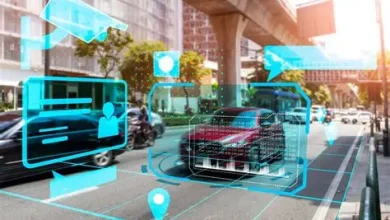
Data centres serve as the foundation of our information infrastructure. As the modern world becomes increasingly reliant on technology in every aspect of work and life, ensuring data centre resilience is essential to keep mission-critical systems active and ready to deliver when needed. This need is especially paramount given the wave of new tools and technologies emerging and integrating into all areas of business operations.
With demand increasing rapidly and AI capabilities advancing daily, it is unsurprising that data centres are expected to consume substantial resources. Without the technology to effectively manage heating and cooling in these structures, waste heat could drive up surrounding air temperature and further heighten carbon emissions.
If not properly managed, this could result in substantial environmental harm. Some studies predict that the AI industry could use as much energy as the Netherlands by 2027. By monitoring consumption, businesses can look to minimise their environmental impact by adjusting use based on data-driven insights, rather than conjecture.
Sustainability must be integrated from project conception, through to delivery and execution. Right from the design phase, it’s important to make the right decisions that will minimise environmental impact and maximise operational resilience.
We’ll look at how data centre infrastructure management (DCIM) software works to monitor, optimise, and streamline the operation of data centres by providing real-time insights that support proactive decision-making.
Hypergrowth ahead
A whopping 40 billion devices are projected to be connected to the IoT by 2030. In the face of this demand, resilient data centres will become strategic imperatives, particularly as AI becomes part of day-to-day business operations.
In fact, three-quarters of data centres currently face increased pressure from AI-driven demands, with only three-in-ten decision makers believing that they are doing enough to enhance the energy efficiency of data centres.
With hypergrowth on the horizon, data centre operators will need new and innovative ways to manage the surge in new devices, ensuring electrical assets are dependable to minimise unplanned downtime.
The next generation of cooling technologies
It is imperative that AI data centre growth is decoupled from the environmental impact. For this to be accomplished, low carbon energy sources need to be utilised, new flexible and efficient AI-ready data centre designs must be developed, and sustainable business practices must be put into place. Traditional power and cooling optimisation technologies will need to evolve if they are to support the demands of higher density racks, which accommodate even greater amounts of computing power.
Technologies such as liquid cooling, software-based cooling optimisation, and advanced airflow management are becoming increasingly popular, making it possible to maintain optimal temperatures whilst consuming less energy. With proper airflow management, operators can ensure that cool air is distributed evenly throughout the data centre, preventing hot spots and improving overall cooling efficiency.
Industry leaders are already making significant progress in addressing these challenges. Digital twin integrations will allow real-time thermal simulations to model heat flow and airflow patterns, better supporting the thermal and power requirements that AI workloads place on data centres. These integrations enable industries to not only mitigate AI’s energy footprint but also use AI monitoring capabilities and insights as tools for broader decarbonisation efforts.
Demystifying the future
It’s true that artificial intelligence itself is creating increased demand for data centre infrastructure. However, it could also hold the key to unlocking energy efficiency gains when it is integrated into data centre infrastructure management (DCIM) software, thanks to predictive monitoring and maintenance capabilities.
When AI is integrated within an infrastructure management system, it collects and analyses data from thousands of sensors, monitoring variables such as temperature, humidity, server loads, airflow, and energy consumption. AI can also learn from external data sources, such as weather data. Instead of controlling cooling based on a fixed schedule, AI aggregates past data and predicted future insights to make adjustments in real time.
This is a gamechanger for data centre operators looking to optimise their resources and prevent existing parts from overheating if a sudden shift in weather, such as a heatwave, occurs. With tools that track energy usage, temperature, and performance metrics around the clock, operators can confidently allocate resources, as well as identify potential areas to optimise energy use.
AI & Automation: keeping eyes on the ball
Along with anticipating shifts in temperature, AI algorithms can forecast hardware failures and schedule maintenance before issues snowball, reducing downtime and waste resulting from burnt out parts. By switching to a more proactive approach, operators can keep equipment performant for longer periods of time, prolonging its lifespan and dependability. Proactive asset management is already proving its worth, with some sites reporting reductions in critical asset failure by up to 60%, with maintenance visits only required every five years instead of every three.
AI technologies are also making a significant difference for data centre operators by automating tedious manual tasks, including backup management, load balancing and system updates. Delegating these tasks to AI not only reduces the margin for human error: it also enables operators to focus their energy on more strategic activities which require a more discerning human eye.
AI is also advancing data centre security through tools such as remote management. By deploying cloud-based AI tools, operators can gain visibility across several sites at once: an especially valuable tool for teams working across hybrid environments. These tools offer operators automated alerting should performance deviate from an agreed baseline. Automated alerting not only reduces the likelihood of human error; it also acts as the ‘eyes and ears’ for data centre operators at any time of day, anywhere. Operators are informed at speed when potential security or equipment issues do arise, so any system vulnerabilities can be addressed in good time, before they impact end-users and services.
Paving the way for a sustainable digital future
In the years to come, data centre managers will face increased pressure to provide resilient, sustainable, and effective operations. As digital technologies become increasingly fundamental to the world’s business operations, ensuring that mission-critical systems remain operational and online will be essential. By leveraging DCIM software that integrates with artificial intelligence, businesses can effectively reduce environmental impact whilst remaining resilient in the face of increasing demand.





